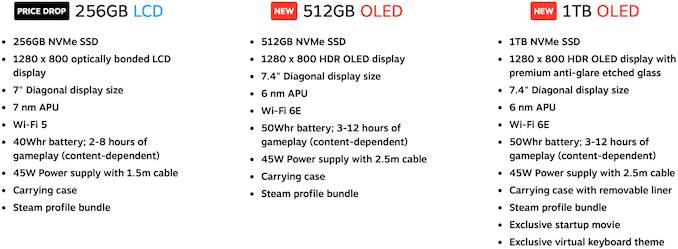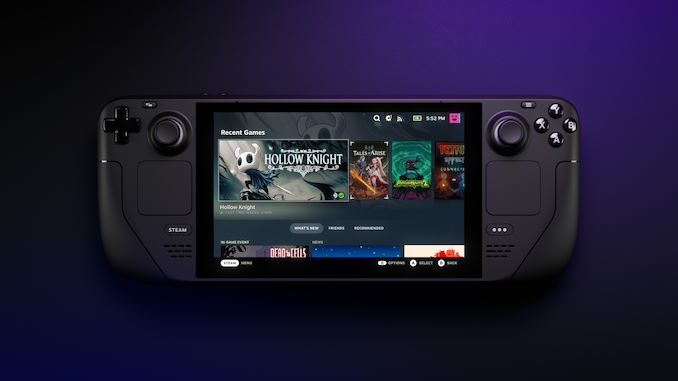Valve's Steam Deck OLED: Bigger Display, New SoC, Faster Memory, More Storage, Same Performance
by Anton Shilov on November 10, 2023 4:00 PM EST- Posted in
- Consoles
- Valve
- Steam Deck

In a quite unexpected turn of events, Valve has introduced a revamped version of its Steam Deck console that got a larger OLED display, a more efficient system-on-chip, a higher-performance memory subsystem, a 1 TB storage option, faster Wi-Fi 6E, and higher-capacity battery. While performance target of the portable gaming device remained the same, the new unit might just be faster than the original one due to faster memory. Meanwhile, the cheapest 256GB version of the console, which retained an LCD screen, now costs $399.
The main difference between the new Steam Deck OLED and the original Steam Deck is the larger 7.4-inch OLED display. The new screen retains a 1280x720 resolution, but it has a 600 nits typical brightness (a major improvement) and also supports HDR with a maximum zonal luminosity of 1000 nits, according to Tom's Hardware. The new monitor can also cover 101.8% of the DCI-P3 color gamut, up from 48.5% in case of the original Steam Deck, our colleagues found out. Despite the larger display, the console retained dimensions of the original one, but got 29 grams lighter since OLEDs do not need a backlighting module and a display driver with all the appropriate circuitry.
Another major change from the original one is that Steam Deck OLED uses AMD's new semi-custom SoC with four Zen 2 x86 cores and an RDNA 2-based GPU with 512 stream processors that is now made on TSMC's N6 process technology. Usage of N6 made the SoC a little cheaper to produce and allowed to retain the original 4W – 15W power envelope without the need to vary GPU clock from 1.0 GHz to 1.60 GHz, which may have a mild positive effect on performance in certain games.
An interesting detail about the new unit is that it uses a 16 GB LPDDR5-6400 memory subsystem with a 102.4 GB/s of peak bandwidth, up from 88 GB/s bandwidth in case of the original one. We can only wonder whether a 16% memory bandwidth boost will significantly affect gaming performance, but we feel it could bring a boost in certain bandwidth-hungry scenarios. Alternatively, faster memory may be just a bit more power efficient.
Speaking of power, it should be noted that the Steam Deck OLED also comes with a 50 Wh battery, up from a 40 Wh battery in the original one, so expect the new one to have a longer battery life. Meanwhile, the new console comes with a longer 2.5-meter power cord.
Yet another notable improvement of the Steam Deck OLED is 1 TB storage subsystem (and the M.2-2230 drive can still be replaced with something different) on the range-topping model. Meanwhile, to download games faster, Steam Deck OLED comes with a Wi-Fi 6E adapter, up from Wi-Fi 5 on the original model.
Valve launches its Steam Deck OLED in time for the holiday shopping system and in addition to make the product more attractive overall, it also makes the platform more accessible. The older 64 GB eMMC model with an LCD screen will be available for $349 while supplies last, whereas the 256 GB LCD version will cost $399 from now on (down from $529). The new Steam Deck OLED 512 GB is priced at $449, while the Steam Deck OLED 1 TB carries a $649 MSRP.
Source: Valve












49 Comments
View All Comments
iphonebestgamephone - Sunday, November 12, 2023 - link
What tests are you referring to when you claim arm is not more efficent than x86?lemurbutton - Sunday, November 12, 2023 - link
The AMD fanboy test of course - Cinebench R23. Just the old version. The one hand-optimized for x86 and incredibly favorable to Zen.Dante Verizon - Monday, November 13, 2023 - link
The ignorance of this comment does not require a response. It's embarrassing just to see it.Dante Verizon - Monday, November 13, 2023 - link
Practically any test that does not run on ASICs, Apple's so-called efficient socs go from 100w stressing only the CPU, discharging in 1-2 hours, nothing different from mobile x86 socs with the disadvantage of needing to run via emulation practically everything.There are special cases where Apple may seem more efficient, but this is due to the combination of software and hardware control, and a lot of expensive moves like massive chips and 256-bit LPDDR memory systems, this works because they have their loyal zombies that go paying for expensive products that deliver a limited ecosystem (for the vast majority.)
The Hardcard - Monday, November 13, 2023 - link
The evidence that you are wrong is pervasive. I don’t know why you wasted everyone’s time with this comment. It’s okay to not like Apple and there are many legitimate arguments to be against any number of Apple’s products and practices.But the CPU cores are superior by a significant amount. They match the top Intel and AMD desktops in all out no matter the power performance across workloads. Add in the efficiency and it’s game over. AMD is not that far off in efficiency at low power. But for highest performance their efficiency fall far behind.
Terry_Craig - Monday, November 13, 2023 - link
He's correct. ARM is not inherently more efficient than x86, especially given the trend towards creating larger cores that replicate earlier stages of modern x86 implementations.Intel often lags behind in the manufacturing process, which can lead to inefficiencies. On the other hand, AMD's APUs are designed with a broader target audience in mind, covering various price segments, instead of exclusively concentrating on creating the largest chip with a focus on ultra-premium efficiency. It wouldn't generate sufficient sales to recover the hundreds of millions invested in its design, and it would also consume valuable manufacturing capacity at TSMC.
The key observation here is that with the transistor budget that Apple employs, it would be feasible to incorporate around 64 Zen4 cores alongside a high-end GPU.
Restrict this setup in comparison to the 145 watts, which is the maximum power consumption of the M2 Max, and you'll be able to determine which option is more efficient: https://www.notebookcheck.net/Apple-MacBook-Pro-16...
Dante Verizon - Monday, November 13, 2023 - link
Yeah, Apple's best chip uses basically the same transistor budget as the mi300x with 19456 shaders and 24 Zen4 cores.iphonebestgamephone - Monday, November 13, 2023 - link
What about the other arm chips then, qualcomm in phones or the ampere server chips?iphonebestgamephone - Monday, November 13, 2023 - link
So any links?Piotrek54321 - Friday, November 10, 2023 - link
No one knows if it's going to finally support adaptive sync?